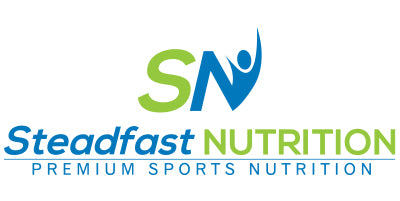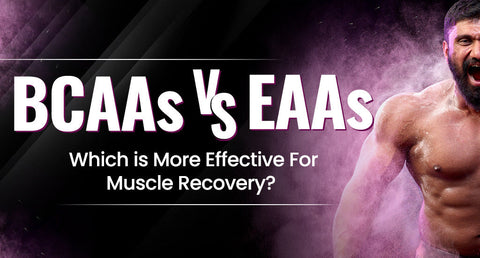Table of Content
After a great workout, it's time to focus on recovery. But should you choose BCAAs or EAAs? With so many supplements available to help you recover faster and build more muscle, it's easy to get confused. Many people use BCAAs, but are just three amino acids enough? Or does your body require all the amino acids that EAAs provide? If you're serious about muscle recovery, it’s time to dive into the science and find out who wins the BCAAs vs EAAs debate.
Understanding BCAAs and EAA
What are BCAAs?
BCAAs, or branched-chain amino acids, are a group of three essential amino acids: leucine, isoleucine, and valine. They get their name from their unique molecular structure, which features a branched side chain. The body cannot synthesise them, so they must be obtained through natural protein-rich food sources or supplements to support muscle growth and athletic performance. BCAAs are metabolised in the muscles, making them readily available during intense exercise sessions.
Functions of BCAAs:
Stimulate Muscle Protein Synthesis (MPS): BCAAs, particularly leucine, stimulate muscle protein synthesis, which helps build muscle.
Overcome muscle fatigue: BCAAs reduce levels of tryptophan — an amino acid that contributes to the production of serotonin, which is associated with elevated muscle fatigue. They also reduce the severity of delayed onset of muscle soreness, aiding in muscle recovery.
Reduce Muscle Breakdown: BCAA supplements contain leucine, isoleucine, and valine, which help reduce muscle soreness after a workout. They also reduce exercise-induced muscle damage by preventing muscle protein breakdown.
What are EAAs?
Essential amino acids or EAAs are amino acids that can not be synthesised by our body, so they must be obtained from dietary food sources or supplements. Interestingly, the nine EAAs also include all three BCAAs. The nine essential amino acids are:
-Histidine
-Lysine
-Methionine
-Phenylalanine
-Tryptophan
-Leucine
-Isoleucine
-Valine
Important functions of EAAs:
Essential amino acids perform several important functions - from building bones, organs, and muscles to supporting immune function and energy production.
Help in Muscle Repair:
EAAs help in muscle protein synthesis, which rebuilds torn muscles after a workout.
Regulate Metabolism :
EAAs are essential for the synthesis of hormones and enzymes which help regulate the metabolic processes. They help in the production of testosterone, growth hormone, and insulin, which regulate key bodily functions such as muscle growth and energy metabolism.
Enhance immunity:
EAAs play a key role in immune function — they are essential for production and synthesis of immune cells and antibodies, which together protect the body against infections.
Key differences between BCAAs vs EAAs
Let’s breakdown the differences between BCAAs vs EAAs for muscle recovery
|
Features |
BCAAs |
EAAs |
|
Amino acids |
Comprise three amino acids: Leucine, isoleucine, and valine |
Comprise all 9 essential amino acids: Histidine, lysine, methionine, phenylalanine, threonine, tryptophan, isoleucine, leucine, and valine. |
|
Main function |
Reduce muscle soreness and fatigue, increase endurance and boost athletic performance. |
Help in protein synthesis, enhance immune response, promote overall muscle growth and repair. |
|
Best timing |
Before or during a workout to boost energy and prevent muscle breakdown |
Post-workout or anytime to fill amino acid gaps |
|
Supplement focus |
Suitable for fitness enthusiasts, endurance athletes, and strength athletes. |
Suitable for people with dietary restrictions or fitness enthusiasts. |
|
recovery strength |
Best for workout fuel; limited benefits for complete recovery |
Best for complete muscle recovery and muscle growth |
Which one is better for muscle recovery?
It all depends on your fitness goals. BCAAs can be taken by bodybuilders, athletes and fitness enthusiasts as workout fuel. They reduce muscle soreness and breakdown during intense training periods. On the other hand, EAAs are typically taken by athletes for recovery after a workout or training session. While comparing BCAAs vs EAAs, the latter are unquestionably superior to the best BCAA supplement when it comes to their benefits for muscle growth and recovery. EAAs not only improve muscle function but also boost immunity and support other body functions.
When should you take BCAAs or EAAs?
When to use BCAAs
To get the maximum benefits of BCAAs, one should take the best BCAA supplement 30 minutes before exercise or during the workout session to prevent muscle breakdown and fatigue, which improves performance.
When to use EAAs
EAAs can be consumed at any time of the day to meet the body’s amino acid requirements. Commonly taken post-workout, EAAs expedite recovery by supplying all nine essential amino acids needed for muscle recovery after intense training sessions.
Final verdict : BCAAs vs EAAs
In the debate of BCAAs vs EAAs for muscle recovery, both support muscle repair. After intensive training, amino acids rebuild and repair damaged muscle tissues. Depending on your fitness goals, you can choose the best EAA supplement or the best BCAA supplement to support recovery and better results. EAAs offer a more comprehensive amino acid profile, providing all nine amino acids needed for full muscle recovery. Meanwhile, those engaging in high-intensity workouts may benefit from the best BCAA supplements during training to prevent muscle breakdown.
FAQ
Q1: Can I take BCAAs and EAAs together?
Yes. Many supplements in market combine both. Since EAAs already include BCAAs, you may not need to take them separately unless you have specific training needs. Additional supplementation with BCAAs may only be necessary for those engaged in high-intensity training. On the other hand, individuals using BCAAs can consider adding EAAs to further support recovery.
Q2: Are BCAAs or EAAs better for weight loss?
Neither BCAAs nor EAAs directly cause weight loss. However, when combined with a calorie deficit diet and a consistent workout routine, they may help promote satiety, reduce cravings and preserve muscles during the weight loss journey.
Q3: Do I need BCAAs/EAAs if I consume whey protein?
Whey protein typically contains both EAAs and BCAAs. However, those involved in endurance sports or bodybuilding training may require additional BCAAs or EAAs under the supervision of a healthcare professional.
Q4: Are there any side effects of consuming BCAAs or EAAs?
No, they don’t have any major side effect. Both are safe for consumption when taken in adequate dosage. Some individuals may experience mild stomach discomfort with higher intakes, so it’s best to follow the recommended serving size on the label. Excessive consumption of BCAAs and EAAs may increase the risk of nausea, bloating or diarrhoea.
Q5: Which is better for endurance athletes and bodybuilders?
It is well known that both EAAs and BCAAs are sources of amino acids, but they differ in amino acid profiles — EAAs provide a complete profile, while BCAAs contain only three essential amino acids. Both include key amino acids that directly influence performance. To prevent muscle breakdown, bodybuilders and endurance athletes can take the best BCAA supplement during exercise, and take EAAs at any time of the day to support overall muscle growth, if needed.


